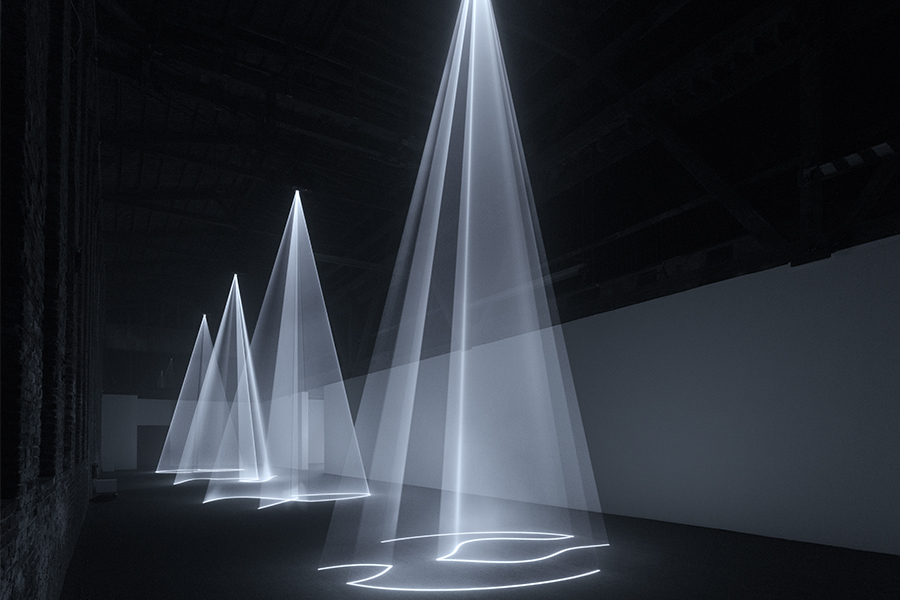5 Questions to Anthony McCall
The installations by Anthony McCall look like painting in light. In his works, he breaks open the boundaries of the film genre, and relies on the participation of the visitors. In this interview, the artist of the Marta exhibition “Deceptive Images” answers five questions.
You began your career as an experimental filmmaker. Where did you get the idea of creating immersive light installations?
As a young artist, I began with the performance of outdoor sculptural events, such as my “Landscape for Fire” and “Fire Cycle” series of 1972 to 1974. I felt the need to document these ephemeral works, and I chose 16mm film as the most promising medium for this. But soon after making a few such records, I was drawn to the films of Michael Snow, Andy Warhol, and others, and I began to think about the materiality of the medium and to entertain ideas for film that were less about recording live performances than they were about film projection itself as the live performance. This train of thought led to the first of my “solid light” films, “Line Describing a Cone”, made in 1973, where the audience was invited to turn their backs to the screen and instead to explore the three-dimensional beam of light that occupied the space between the projector and the projection wall opposite.
At the beginning you showed your film installations in old New York lofts where dust and smoke made the light “visible”. What changed for you when your works were presented in professional exhibition spaces?
The early “solid light” works were shown in those alternative public spaces in New York which showed young artists and filmmakers early in their careers: places such as Artists Space, The Clocktower, The Idea Warehouse, Collective for Living Cinema, Millennium Film Workshop, and others. What all of them shared were rough-and-ready, turn-of-the-century, loft/warehouse spaces that provided artists with cheap studio space and were not so different architecturally from the lofts in downtown Manhattan. When I was invited to participate in a large group survey exhibition, “New Media I” at the new Malmo Konsthall in Sweden in 1975, I was pleased because it would be my first showing in a museum space. However, that showing of “Line Describing a Cone” was not a success. The volumetric cone of light that in the past had always materialized, failed to reveal itself. It was then that I realized that it was the dust, always reliably present in our old downtown lofts, as well as the smoke from cigarettes, which provided the essential medium that made my films visible. In this new, pristine, concrete-and-glass building, there was no dust or smoke in the air that would have guaranteed the visibility of the membranes of light. The film, conceived as a three-dimensional sculptural form slowly coming into being, was simply not there to be seen.
After you withdrew as a practicing artist at the end of the 1970s, you resumed work on your “solid light” works around 20 years later. How did that come about?
Twenty years later, many things had changed. In the 1970s, my „solid light“ works were understood as part of an avant-garde cinema tradition, a category that private galleries and museums rarely showed. But by the mid-1990s, things had evolved, and most private galleries and public museums had begun to show moving-image work. Perhaps the key thing for me in the 1990s was the invention of the haze-machine, a small black box that was able to fill any darkened exhibition space, small or large, with a thin mist, which would make visible the cones, blades and chambers of my „solid light“ series. And when I started again in the early 2000s to add new work to the earlier series, I moved from 16mm to digital production. Ceiling-mounted digital projectors enabled me to open up a (still ongoing) series of vertical works, such as “You and I” (2010), which is installed in your exhibition here. I have now completed about 45 “solid light” works, of which 15 are vertical in orientation.
Which elements of your work would you describe as photographic and which as painterly?
Whatever else they are, each of these works is a simple line-drawing, projected onto the wall (in the case of a horizontal work), or onto the floor (in the case of a vertical work). This takes place in a darkened exhibition space. The line drawing combines with the mist in the air from the haze-machine to produce a sculptural volume in three-dimensional space. However, the line and the sculptural volume also mutate over time, such that the form is slowly and continuously on the move, giving the projection its cinematic face.
In your immersive light-installations, the visitors become part of the work. Which role does their participation play for you?
Individual visitors inhabit and explore a shifting conical volume, interrupting the translucent membranes with their hands and bodies, and negotiating with one another an apparently “tactile” social space.


